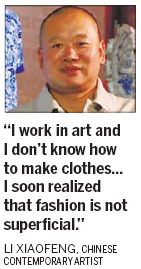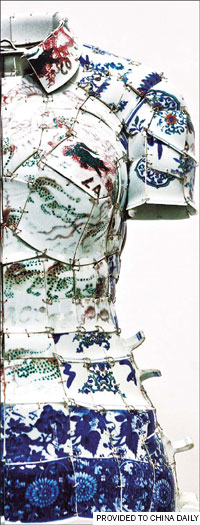Life and Leisure
Piece Deal
By Gan Tian (China Daily)
Updated: 2010-11-29 14:10
 |
Large Medium Small |

What happens when an established French fashion label meets a Beijing contemporary artist? Gan Tian looks at the result.
When French fashion label Lacoste's artistic director John Storey was in Beijing this January, he happened on two installations in the lobby of the Opposite House, the luxury boutique hotel where he was staying. They were two costumes - one a qipao, the other a Mao suit. The materials, however, were not cloth but pieces of Chinese porcelain shards. Storey's curiosity was aroused. Why porcelain shards? To find out, he went to the Red Gate Gallery, where contemporary artist Li Xiaofeng was working.
After Li told him the origins of his ideas, Storey offered him a partnership with Lacoste. "My first response was: I work in art and I don't know how to make clothes. I was about to say 'no' at that moment," says the 45-year-old artist.
But the Lacoste staff started to share the label's background with the artist, and Li, who knew nothing about fashion, began to understand a little more about Lacoste.
"I did some research, and found Lacoste was founded in 1933, which makes it a long history. I soon realized that fashion is not superficial."

Li is the latest contemporary artist joining Lacoste's Holiday Collector's Series. Since 2006, Lacoste has invited many artists around the world to collaborate, in order to interpret the label's different lifestyles in different countries.
Following in the footsteps of the two pieces exhibited at the Opposite House, Li made two polo shirts out of porcelain shards for Lacoste, which recently debuted in Beijing. There are 275 porcelain pieces used in the men's polo shirt and a few more in the lady's version. The shards are all from the Qing Dynasty's Kangxi period (1661-1722).
Li painstakingly gathered the historic materials over three months, buying them from different collectors, and even went to construction sites to rummage for more.
"Everybody knows Beijing is a big city. Beijing today is a big construction site. Property developers have turned Beijing upside down. Ancient cultural relics from the Tang, Song, Yuan, Ming and Qing dynasties have been pushed up from below the surface through this upheaval," he says. Li took photos of each piece, and then scanned them into the computer. His last step was to put them together like a jigsaw, into the shape of a human body. The process started with plasticine and wire to create a model, and then he classified the pieces by color and pattern, putting together a rough arrangement. Later, each piece was cut and polished.
"This is a very repetitive process. I must pay close attention to the modeling as well as the original pattern and color of the porcelain. Then, I must weld them together and make the final adjustments."
He says he can better express what he wants through the patterns on the shards and the modeling.For example, the collar has a complex motif combining a phoenix and a crocodile. Li points out it represents a melding of cultures: the phoenix is a symbol of ancient Chinese royalty, while the Lacoste's crocodile represents the West.
Even the process is a cultural mix. The porcelain pieces are undeniably Chinese while the polo shirt is definitely Western, a creation by Lacoste founder Rene Lacoste, a famous tennis player. He was uncomfortable with what was worn on tennis courts at the time, and so he designed the loosely knit cotton shirt with short sleeves, a flat collar, and a placket with buttons that was to become the polo. He wore it at the 1926 US Open Championship for the first time. "China has a cultural and artistic capacity. It has been the foundation of many artistic creations," says Michel Lacoste, the label's chairman of the board. "We felt Li had the capacity to reinterpret our polo shirt. He has a very interesting personality, and we spent a lot of time together in Paris this May." Lacoste had a close look at what Li had been doing, and he found it was extremely interesting, because the artist "combines the past and the present".
"This is exactly what we are trying to do," he adds.
Two of Li's porcelain polo shirts are included in Lacoste's Holiday 2010 Collector's Series. The label also launched the printed Porcelain Polo series worldwide, limited to 20,000 pieces for both men and women.